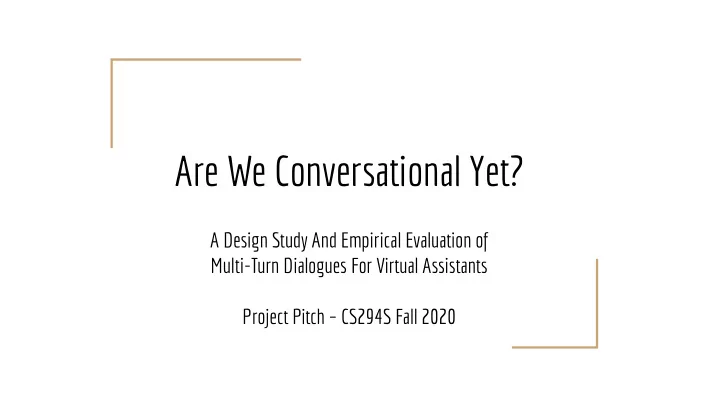

Are We Conversational Yet? A Design Study And Empirical Evaluation of Multi-Turn Dialogues For Virtual Assistants Project Pitch – CS294S Fall 2020
Almond is out there, now what? Almond 1.99 released in September 2020 ● First assistant to support multi-turn dialogues ● using a contextual neural network Automatically generated replies, suggestions and follow-ups ● So we’re done right? ● Spoiler: Almond doesn’t work ●
Happy vs. Unhappy Paths Wizard-of-Oz dialogues are mostly happy paths ● Both the agent and user have a common goal of completing the transactions ○ They are playing along with no surprises and with no “computer errors” ○ 90-10 rule in software engineering: ● We need to spend 90% of the effort to handle the last 10% (due to exception handling) ○ In NLP dialogues, given the expected failures in NLP, this is higher. ○ What are possible causes of unhappy paths? ●
Modularizing The State Machine Developers concentrate on the application-specific logic ● Common modules take care of completing a “command” ● E.g. Slot filling is a “mini-dialogue” ○ inserted for every incomplete request Model the major unhappy reasons and alternative paths abstractly ●
Challenges How do we control the dialogue agent to minimize unexpected answers? ● User studies to evaluate different kinds of agent responses. ○ What methodology can we use to identify the abstract dialogue acts in ● unhappy paths? Are there transcripts? How do human agent transcripts compare with AI agent ○ transcripts. Can we role play? Can we crowdsource at scale? ○ Can we assume that language variations with the same intent can be handled ○ automatically? (like auto-QA) Hypothesis: the first 70% is easy; the rest needs iterative refinement after deployment. ○ Tools are necessary. Can we create a “backoff” scheme, such as reading the possible choices ● that the agent can understand? (like a menu)
High-level Project Plan Step 0: Familiarize with existing Almond ● https://almond-dev.stanford.edu + ○ https://github.com/stanford-oval/thingpedia-common-devices Step 1: Pilot study to identify happy and unhappy paths ● Small scale crowdworker test or even with friends and family ○ Step 2: Expand (or contract) dialogue capabilities to improve success ratio ● Step N: Iterate until success ● Step N+1: Profit! ●
Schedule Create a strawman of possible abstract states (2 weeks) ● Test Almond to get an intuitive feel ○ Try a small-scale formative study to gauge user responses. ○ Design a crowdsourcing experiment for a small domain (2 weeks) ● If the results are reasonable, ● implement a subset of the dialogue and test on users (2 weeks); If not, try another experiment.
Why You Should Work on This Project Dialogues are the next big thing for assistants ● We all experience really bad customer support over the phone! ○ The first round is the low hanging fruit. ○ We have a secret weapon ● The contextual neural network is our state of the art model nobody else has. ○ Get To Research Quick : infrastructure is already built ●
Recommend
More recommend